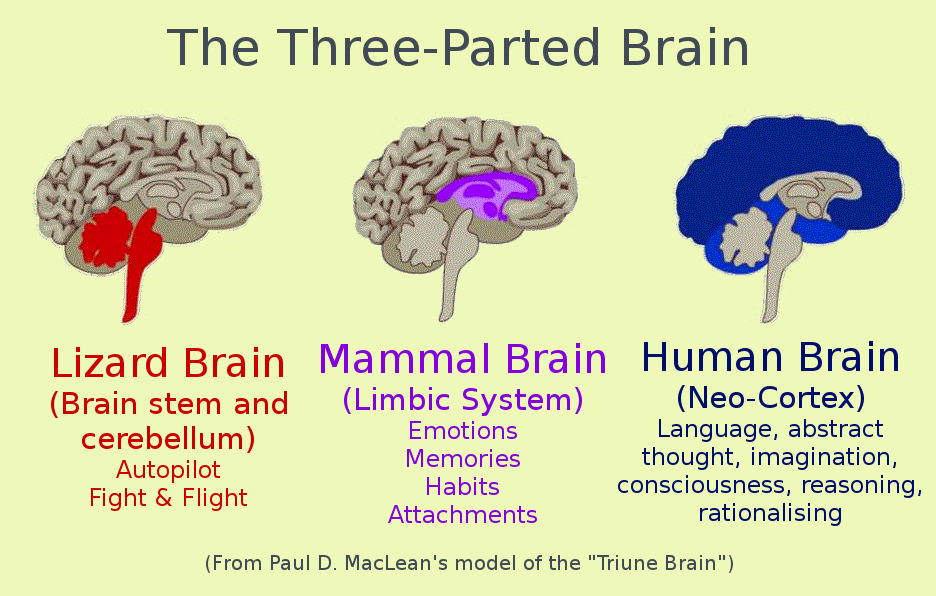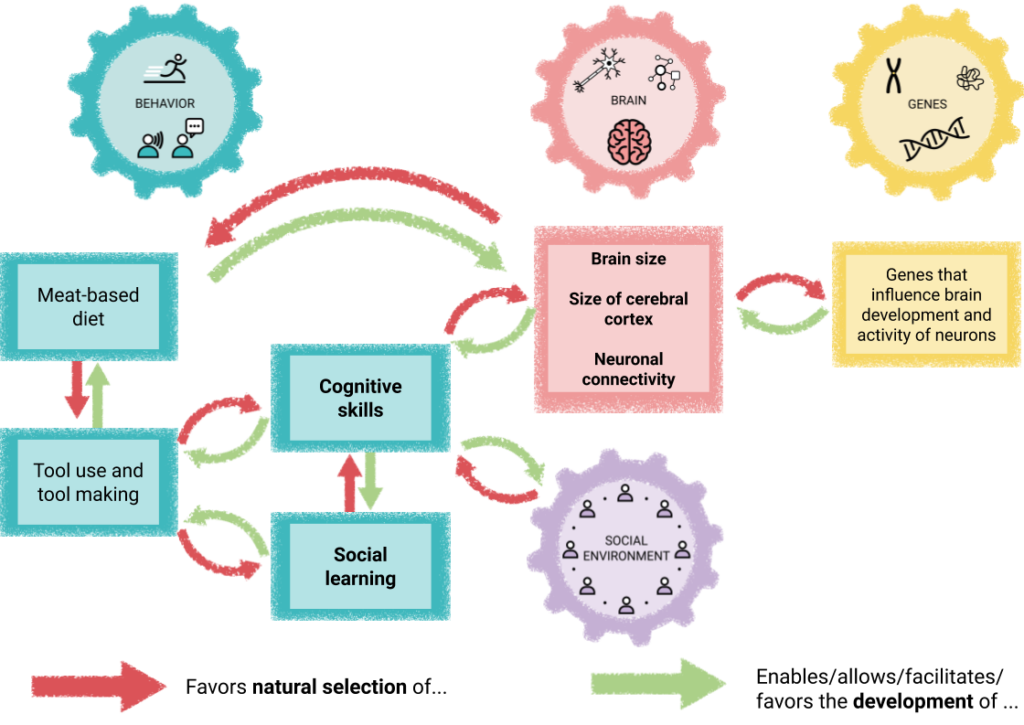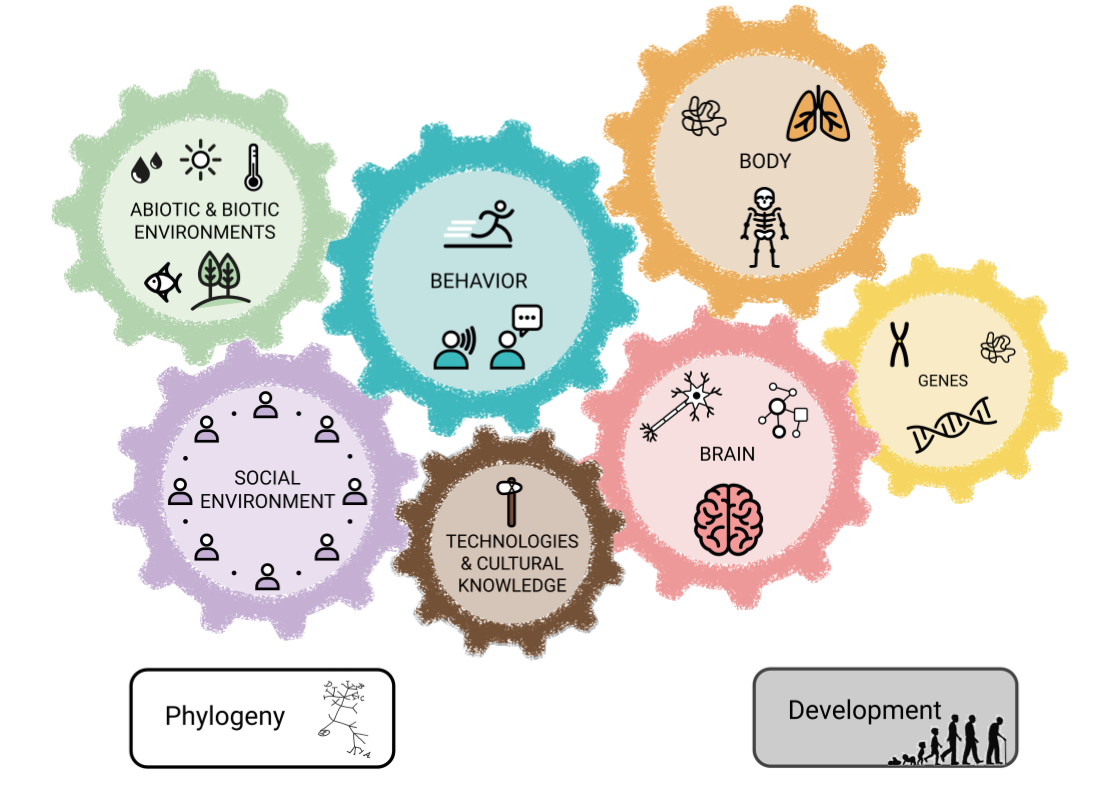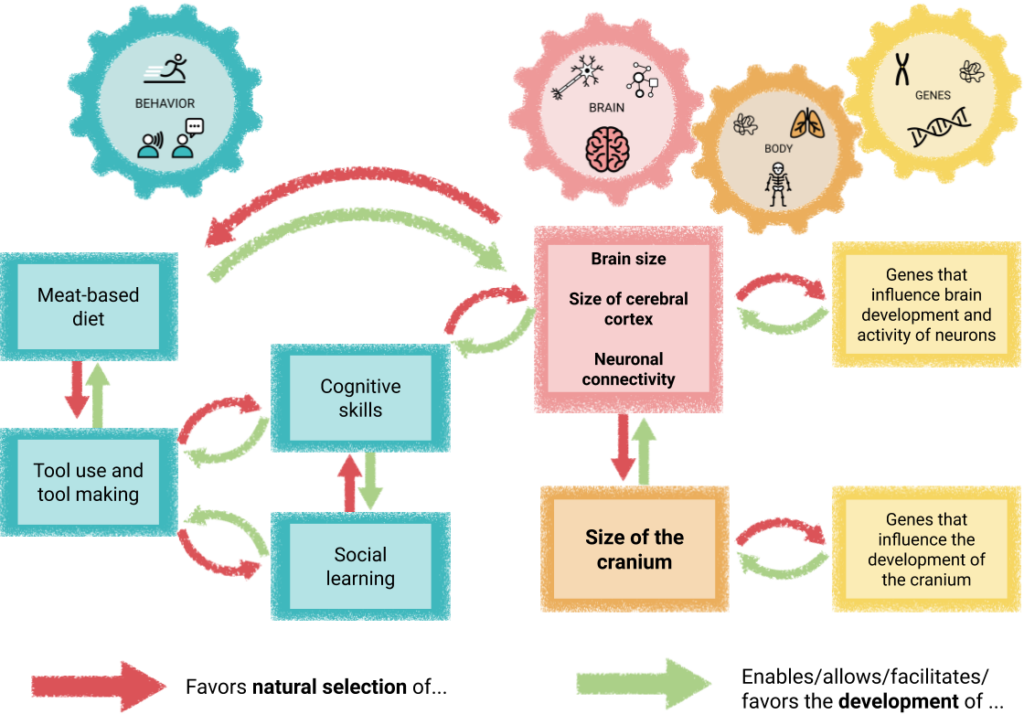
Reading text – brain areas and their functions
A handout about the “Triune Brain” model highlighting different functions of different brain regions
One of the most striking and well-known features that characterize our species is the size of our brain. The size of the brain in turn implies the high intelligence of our species. But brain size does not necessarily correlate with level of intelligence – big animals like whales tend to have bigger brains and a higher number of neurons because more information has to be processed from the body.
Because of this, biologists tend to look at the relative size of the brain compared to body size to compare the brains and cognitive abilities of different species. But even then there are problems if we want to compare the brains between species of different sizes: the smaller an animal, the more proportion the brain usually has in its total body weight: the brain of an ant makes up about 14% of its total weight, for a hippopotamus it is only 0.04%.
Biologists therefore calculate the so-called encephalization quotient, which takes into account the differences in body weight between species.
In these calculations, the human brain still stands out – it is much larger than one would expect from the size of the human body.
In addition, biologists look at the relative size of different brain regions. In the human brain, it is noticeable that the cerebral cortex has a particularly large number of nerve cells.
If we look at the fossil skulls of our ancestors, we find that their sizes, especially the cranial capacity, increased more and more starting around 2 million years ago. This gives as an indication about the increase in brain size during this time period.
But how can we explain the evolution of a big brain? Why has brain size increased in the course of our evolutionary history, and why does our species have such a relatively large brain? If a big brain and intelligence are so “great,” why don’t other species also have a bigger brain?
The brain is the most energy-intensive organ in the human body – it consumes 20-25% of the energy, while it accounts for only 2% of the weight. Such an “expensive” brain has to “earn” that energy expenditure by fulfilling important functions for the survival and reproduction of a living being. Otherwise, individuals with a smaller brain could survive and reproduce just as well or even better because they would save energy. The brain size would then not increase in the course of evolution.
The human brain is made up of several regions. We inherited them from our ancestors because they performed vital functions, and we have them in common with various animal relatives. However, the relative size of the brain regions has changed in the course of evolution. In humans, for example, especially the cerebral cortex greatly increased.
In a very simplified way, we can think of the brain as being organized in three layers or regions. These parts carry out different functions for the organism, and they are – from an evolutionary point of view – “younger” or “older”.

“Reptilian brain” (brain stem and forebrain)

“Mammalian brain” (Limbic system)

“Primate brain” (cortex)
In reality, these regions and their functions are strongly linked. So we can think about a possible stressful situation of tomorrow, while inadvertently getting sweaty hands or showing other stress reactions. On the other hand, we can notice that our body is showing certain emotions and sensations, which then make us think and reflect. For us, the task “12 * 12” may be difficult to solve at first, requiring strained thinking (working of the cerebral cortex), and then progressively becoming an intuitive response through continuous practice and repetition. Thus, the activities of the cerebral cortex and the other brain regions are almost always linked. Furthermore, “primate brain” does not mean that only primates have a cerebral cortex, or that only primates can have high cognitive abilities.

A handout about the “Triune Brain” model highlighting different functions of different brain regions

In this lesson students sort their own experience of thinking into fast and slow processes. Based on this, they come to understand that our thinking is shaped through experience such that things we do often and regularly become easier over time.
Anthropologists suggest that for our ancestors living 2 million years ago, survival and securing a high-quality diet under the environmental conditions in the savanna depended more and more on the use of tools, in addition to the ability to cooperate, run long distances and throwing skills. So there was a high selection pressure on the use and production of good tools. Those who learned how to make good tools quickly and efficiently had better chances of survival and reproduction than others.
Better at making and using tools were those that had certain cognitive abilities, such as endurance, ability to concentrate, control and coordination of body movements, short-term memory, problem solving, control of impulses and the skills for social learning. After all, the use and manufacture of tools had to be learned in the course of one’s life.
These are functions that particularly involve the cerebral cortex. The more nerve cells are present and the more these nerve cells are networked, the stronger these skills can develop in the course of a lifetime. Thus, those whose brains had more nerve cells (especially in the cerebral cortex) and increased networking of nerve cells, could develop better skills for learning and executing the making of tools, and thus had better chances of survival and reproduction. Thus, there was a selection pressure on an enlarged cerebral cortex and other factors of brain activity that affect these mental abilities. Genes involved in the development of these brain characteristics were inherited to their offspring, which also had higher chances of developing these characteristics.
Since the brain is the most energy-intensive organ in the body, the development of a larger brain also required a stable supply of high quality food sources. Thus, there was a kind of feedback loop between diet, cognitive skills, and brain size, which may explain the exponential increase in brain size during the last 2 million years of our evolution.
Furthermore, starting around 2 million years ago, the social life of our ancestors was beginning to become more complex. Some anthropologists suggest that this also increasingly required a kind of social intelligence besides the technical intelligence required for tool making. Our ancestors had to keep track of who is doing what in the group, who is standing where in the hierarchy, who is a good cooperator, who is a cheater or slacker. The social environment may thus have also provided increased selection pressure on cognitive skills, which in turn may have posed increased selection pressure on brain size.


All causal maps on human evolution in one Google slide file
Additional reflection questions:
Looking at the fossil skulls of our ancestors, we find that the size of the cranium increased. This is taken as an indication of an increase in brain size during our evolution.
How can we add the body feature of cranial capacity to the above causal map on the evolution and development of the brain?

Reader, S. M., & Laland, K. N. (2002). Social intelligence, innovation, and enhanced brain size in primates. Proceedings of the National Academy of Sciences, 99(7), 4436–4441. https://doi.org/10.1073/pnas.062041299
Shultz, S., Nelson, E., & Dunbar, R. I. M. (2012). Hominin cognitive evolution: Identifying patterns and processes in the fossil and archaeological record. Philosophical Transactions of the Royal Society B: Biological Sciences, 367(1599), 2130–2140. https://doi.org/10.1098/rstb.2012.0115
Street, S. E., Navarrete, A. F., Reader, S. M., & Laland, K. N. (2017). Coevolution of cultural intelligence, extended life history, sociality, and brain size in primates. Proceedings of the National Academy of Sciences, 114(30), 7908–7914. https://doi.org/10.1073/pnas.1620734114
van Schaik, C. P., Isler, K., & Burkart, J. M. (2012). Explaining brain size variation: From social to cultural brain. Trends in Cognitive Sciences, 16(5), 277–284. https://doi.org/10.1016/j.tics.2012.04.004
OpenEvo is an educational innovation project from the Department of Comparative Cultural Psychology at the Max Planck Institute for Evolutionary Anthropology.
Evolve the future of education with us!